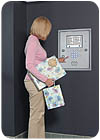
A building directory of residents can be scrolled through on this panel.< br /> PHOTO COURTESY OF LINEAR LLC
Entry control in multiple-unit commercial or residential buildings such as multi-tenant office buildings or residential apartments or condominiums brings a different set of design and installation considerations and standards than for networked or single-door access control systems.
Telephone entry, intercoms or automatic dialers are used in many of these buildings to gain access. Gated entry systems for vehicles also bring their own set of design and installation variables.
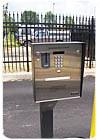
A card reader is built into the faceplate of this telephone entry and access control system, which typically is used in gated communities and apartment complexes.< br /> PHOTO COURTESY OF DOORKING
This means the general public needs entrance to the first through third floors when the shops are open, and customers of the businesses on the fourth floor during business hours, but access to the rest of the building must be restricted to owners, tenants and their visitors.
Besides telephone entry or automatic dialers for customers or employees of the businesses on the fourth floor, another possibility is restricted access for the fourth-floor business tenants by location and also time.
Residents on the upper floors would need unrestricted access to their floors but restricted access to the business and retail floors except during business and retail hours. They also may need restricted or 24-hour access to specialized areas like laundry rooms, swimming pools or health clubs. Elevator control is a possibility in situations like this, and integrating all the different systems is a challenge.
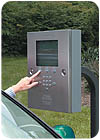
Gated communities are an opportunity for several types of entry control equipment to be used. Prompts explain the use of this community’s directory of residents. < br /> PHOTO COURTESY OF LINEAR LLC
Biometric devices such as fingerprint scanners, palm geometry, vein authentication, iris readers and facial recognition devices are used where a higher level of security is needed. Although the cost of fingerprint scanners is decreasing and many can be integrated through the 26-bit Weigand code they use to communicate, most installations use less expensive technologies like proximity cards or keypads.
Some creative multi-use building access control products have been developed, such as virtual audio or video receptionists who appear on computer screens. However, these are more expensive than conventional systems and usually are utilized where the additional technology is needed to create a highly technological or upscale image that justifies the additional cost.
Wired or wireless intercoms are used mostly for residential buildings such as single-family homes or multi-unit apartment buildings. Telephone entry or hardwired entry control systems are considered by many to be more upscale and versatile than intercom technology.
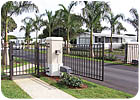
Gated communities are popular in Sun Belt states along the southeastern and western coasts of the United States and in the Southwest and Texas.
PHOTO COURTESY OF DOORKING
PHOTO COURTESY OF DOORKING
TELEPHONE ENTRY
Richard Sedivy, director of marketing for DoorKing Inc., Englewood, Calif., has seen innovative uses of entry equipment.“We have one installer based out of Cheyenne, Wyo., who does a lot of ranches,†Sedivy recalls. “I’ve seen him put telephone entry systems in boulders or build them into a living tree. These are money’s-no-object types of installations.â€
Tree stumps or rocks for such entry systems also can be fabricated. “Some of these guys out there are really good,†Sedivy declares.
Many of today’s telephone entry systems actually make local phone calls to a building’s units through their telephone lines. Tenants then can answer through a wired or wireless or even cellular telephone. A telephone entry system also can be connected to a unit’s phone lines so no outside call is needed.
“Telephone entry basically provides a way in which you can talk to and sometimes visually see who’s out there,†explains Milt Sneller, CEO of Trigon Electronics Inc., Corona, Calif. “Most of them are interactive with the telephone system.â€
Adds Sedivy, “Telephone entry and everything else is going more towards a PC-programmable type system, where instead of programming on the keypad, everything is computer-based. There’s live reporting available with these types of systems, where every time an event happens or someone gains entry, it sends data back, and you keep track of that.â€
Prices of such systems are decreasing and units are becoming more compact, Sedivy reports. They also are becoming more user-friendly, which will be good news to anyone who has stood in the rain outside a building trying to figure out how to contact a building resident to gain entry.
Some high-end systems use voice prompts to guide the user. “A telephone entry system can look pretty intimidating to someone who’s never seen one before,†admits Chuck Stevens, vice president of marketing, Linear LLC, Carlsbad, Calif. He thinks voice prompts will start to be used in more moderately priced systems.
“Sometimes you can get too innovative,†concedes DoorKing’s Sedivy. “We have to remember that on a telephone entry system, you have a product out there that people come up to, and it’s got to be extremely simple to use, because your instructions are limited to what you can display on a screen, what you can feed back to them audibly and what you can put on a placard.
“So the system has to be intuitive,†he emphasizes. “It’s like a computer program -- it does all these wonderful things, but, for example, people who use Microsoft Word use only 10 percent of its capabilities.â€

Sleek styling can add upscale appeal to wired entry systems.
PHOTO COURTESY OF AIPHONE
PHOTO COURTESY OF AIPHONE
To determine how much abuse these types of equipment can withstand, Underwriters Laboratories has developed the UL 294 standard, which includes what is called an attack test.
“The attack test basically says that the entry system has to withstand a vandal attack for five minutes, and the attacker can use hammers up to 3 pounds and crowbars not to exceed 18 inches in length,†Sedivy notes. But he points out that the strength of the person is never specified, whether it is “a 400-pound gorilla or a 90-pound child.
“The standard does not adequately state how to perform this test, so it is very subjective,†he asserts. “By that I mean that different test engineers will apply different methodologies to test a system, and you can come up with different results from the same standard, which indicates it’s a badly written standard.
“To that end, we’re working to try to update that standard and even the playing field across the board so every manufacturer knows what to expect when they submit for UL 294 testing,†he relates.
Another factor is using the proper gauge of wire. To power the telephone entry system properly, 18-gauge wire is recommended. Some systems recommend using Cat 5e cable for data.
Lightning strikes also are a possibility that would cause a power surge to come down the line, so surge protection and grounding is needed.
Using a dedicated phone line for each entrance is not required but recommended by Paul Jones, a field applications engineer for Linear. “You can share a line, but if somebody is using unit A and another person tries to use unit B, it will say to try again later,†Jones explains.
The phone line should be an analog POTS line or fax line, not a voice over Internet protocol (VoIP) line, Jones recommends.

This telephone intercom system in New York City uses RJ71C phone company punch down blocks. It provides communication from the lobby panel to the residents’ apartments via their telephones.
PHOTO COURTESY OF DOORKING
PHOTO COURTESY OF DOORKING
GATED COMMUNITIES
Gated communities are an opportunity for several types of entry control equipment to be used. Besides gate operators, telephone entry systems may be used along with wireless access devices and various types of access control cards.The growth of gated communities is most pronounced in Sun Belt states along the southeastern and western coasts of the United States and in the Southwest and Texas.
“It’s a trend that we have seen growing exponentially each year for the last four or five years,†reports Randy Planck, director of the commercial products division for The Chamberlain Group Inc., Elmhurst, Ill. “In Las Vegas, there are now hundreds of gated communities.â€
Telephone entry systems for gated communities in the past have not always been handled by security dealers and systems integrators.
“Telephone entry is an up-and-coming category for our low-voltage guys,†declares Linear’s Stevens. “In the past several years, it’s started to make some inroads with the traditional security integrator/installer. In the past, most of the telephone entry systems were installed or subcontracted by the guy who did the gates and fencing.
“A lot of these systems were sold through specialty distributors who handled gate operators, so you didn’t see nearly as many telephone entry systems being installed by our low-voltage dealers, integrators and installers as you see today,†Stevens adds. “It’s a huge market, by the way. Our business level with this installation group has tripled in the last year.â€
Adds Planck, “The goal in setting up and installing these access systems is to make them very user-friendly and simple to get in and out of.â€

Some wired entry systems can provide video from the entry point.
PHOTO COURTESY OF AIPHONE
PHOTO COURTESY OF AIPHONE
Another system that saves installation time is wireless gate access transceivers at secondary access points. These can communicate wirelessly with the main telephone system, thereby saving on trenching and installation of underground cable.
Transaction logs keep track of who granted access to visitors and video even can be installed so the person requesting access can be seen and a record kept. Temporary access for a day, week or one-time event also can be allowed for repair people or other guests.
Installation tips for systems controlling gated entrances include making sure the systems are properly grounded, the correct gauge and type of wire is used, the communication wire is not run close to power lines to reduce electrical interference and the proper surge protection is provided.
“The biggest reasons for callbacks on such systems are usually related to grounding issues,†Planck reports. The company recommends following the electrical grounding codes in an installation’s area, which often includes installing a copper grounding rod.
“It’s very hard to protect equipment, but whenever possible, you want to pay close attention to surge protection,†Planck recommends. “That will prolong the life of the equipment and reduce callbacks and unnecessary servicing.â€
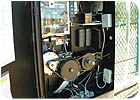
A hybrid system at the Rockland Airport that uses radio frequency devices on a sliding gate was installed by Cincinnati Time of Maine, Portland, Maine.
PHOTO COURTESY OF AMANO
PHOTO COURTESY OF AMANO
DEDICATED WIRED SYSTEMS
Dedicated wired entry control systems and intercoms remain popular as an alternative to telephone entry systems that place local calls on leased telephone lines because the expense of a phone line is unnecessary, points out Bradley Kamcheff, marketing manager for Aiphone, Bellevue, Wash.Additionally, he thinks dedicated wired systems provide a higher level of security through the use of video door station entrance panels which can be interfaced with CCTV and access control systems.
Using a dedicated entry system also removes the possibility of gaining access through a telephone entry system by playing back the correct Touch Tones with a cell phone through the telephone transmitter, a security breach of which not many are aware.
Dedicated systems offer convenience for tenants by making sure they never miss a visitor because the phones are down or their cell phone is turned off. However, use of such a dedicated system usually requires tenants to go to the master station in their unit.
Some wired systems can accommodate up to 500 units and provide panels at up to 16 entrances. Dedicated systems also have the capability of using access control devices like proximity cards.
Buildings under construction for which telephone wire has to be strung also can have dedicated entry system wiring pulled at the same time to reduce the expense of separate installation. Large apartment buildings and nursing facilities frequently are customers for these systems.
“It works out very well for people who are planning out their buildings,†Kamcheff notes. “They’re at the stage where the architects are looking for just the right system to make the building look attractive while providing a more secure and convenient environment.â€

The card reader is integrated into the gate control system at the Rockland Airport.
PHOTO COURTESY OF AMANO
PHOTO COURTESY OF AMANO
GIVING THEM THE GATE
Gate systems also are mostly PC-based nowadays. The four main types of gates slide, swing open, raise like a toll booth or parking lot gate, and ones on which the operator is actually attached to the gate.Adoption of a standard for gates, UL 325, in 2000 caused many companies to switch to a microprocessor-based control board so they could handle all of the standard’s requirements.
“Some things we can do now is we have the gate operator sending data back to the access controller, and it tells how many cycles the gate has run, if there was any shorted input, or if an obstruction has been hit,†Sedivy explains.
Efforts were made with the standard to improve gate safety and reduce incidents in which people accidentally were caught in the gates or the gates came off their tracks and fell on people.
Control of gates also must take into account their potential misuse, such as children riding on gates that slide open horizontally or people getting their hands caught in gates they reached through to activate their opening.
“Nowadays you have to plan for improper use of your product,†Sedivy warns.

Two telephone entry systems are mounted on a dual gooseneck mounting post. The lower unit is for people in cars, while the upper unit is used by persons in trucks or RVs.
PHOTO COURTESY OF DOORKING
PHOTO COURTESY OF DOORKING
Side bar: Telephone Entry System Alternatives
The type of telephone entry system used may be determined by the way local calls are handled by the area’s phone company.If unlimited local calls are allowed, installing a simple phone line to the telephone entry system is all that is needed. That phone simply telephones the residents of the building by automatically dialing their phone numbers.
However, if local calls are charged individually, as in some areas of the northeastern United States, such a system can result in higher cost. Then a no-charge phone intercom system may be installed.
This installation is more complex because it directly wires the entry telephone into the building’s telephone system so each unit is contacted through the building’s telephone wiring.
Although it is more expensive to install, such a system is less costly to operate because there is no charge from the phone company for each call. Some of these types of systems also can call down to the lobby, such as to a doorman in an apartment building or a security guard in an office building.
Sometimes installation of such systems is complicated by the telephone company’s insistence that it install the equipment itself because it connects to the phone company’s cables.
Another possibility is hardwiring the telephone to each unit. “That’s done more when there’s very few apartments,†explains Milt Sneller, CEO of Trigon Electronics Inc., Corona, Calif. “If it’s down to around 12 apartments, it might be reasonably cost-effective to go in and pull wire to each apartment.â€
Telephone entry systems have a transaction log that can store several thousand transactions depending on the amount of memory the system has. The log includes a list of everyone who let someone in and the time at which the person or persons were allowed entrance.
The log can be downloaded directly to a computer that is connected by a doorman, security guard or other person on-site or remotely through the Internet.
Among the trends Sneller sees in telephone entry equipment is using LCD screens on the entry systems and being able to connect the phone entry system into an industrial or commercial building’s local area network (LAN) so voice over Internet protocol (VoIP) telephone service can be used.
Sidebar: Entry with Entire System
LCD color screens for visitor entry can be integrated into a building’s entire management system, suggests Stephen Pineau, CEO, Viscount Systems Inc., Burnaby, British Columbia, Canada.“Customers are moving much more heavily for telephone entry to higher-end products that allow them to brand buildings, because full-color screens allow them to put management information, screen savers and to communicate to people rather than just a list of names,†Pineau insists. “Everything then can become a single system instead of a whole bunch of bits and pieces.’
He suggests using touch screen panels with built-in video so images of visitors can be logged in with their time and date of arrival.
“This allows management companies to network all their buildings in a single database so they can manage individual tenants better and maintenance people can be added to multiples of buildings without having to dial by modem individually,†Pineau points out.
“You have an accurate list of who goes in and out with these systems,†he points out. “People post site maps on the screens so people know where to go once the gate opens.
“The technology is changing rapidly to IT, and it blows the door off the limits of firmware-based systems,†he insists. Even though the systems appear more expensive, their benefits and greater efficiency actually make them less expensive, Pineau thinks.
“One downside that is happening in condominiums is some developers are probably putting fancy systems that become to some degree a burden for the owners when they take ownership of the property, because who does all the repairs and who pays for it?†he asks. “So that’s kind of the catch-22 for developers.
“The trends are going to IT because systems will be more powerful, but on the other hand, one of the downsides is that platforms tend to change more rapidly than traditional hardware,†Pineau notes. “I guess one of the things we worry about is to make sure that for multi-unit residential applications that you have equipment that can serve a long life cycle.
“With traditional hardware, equipment stays around for 10 years,†he estimates. “People in residential developments think very poorly of equipment that only has a two- to four-year life cycle. It’s something probably all companies have to be cognizant of.â€
Sidebar: Cellular Networking
One trend in multi-unit building access management and gate control is using systems that can be networked and managed remotely through cellular phone connections. Gates can be networked at the same location or accessed remotely via the Internet with such systems.Multi-unit access systems also can be managed remotely, which aids management companies that may have properties in multiple locations that are distant from each other.
Brivo Systems LLC, Bethesda, Md., started in the niche market of gate installation, relates Christie Walters, director of business development and marketing, because its product did not require installation of wires.
“Our first niche market was gated applications, primarily in places like small airports or utilities where they would utilize multiple gates,†she recalls.
Trenching wires to connect the gates would be costly, but with her company’s system, which communicates directly with a central hosting center, such connections were unnecessary. Increased security, especially at smaller, established airports, has been a concern and driven this business, she notes, because other options like laying fiber-optic cable or using Wi-Fi is cost-prohibitive.
The business’ specialty has since branched out to include individuals with multiple homes who need to control gates or other access remotely and businesses with multiple properties.
“We find that we do about 60 percent of our business with property management firms, primarily because the managers tend to have responsibility for a lot of locations and a lot of tenants,†Walters explains. “A lot of third parties involved in that process typically are not locations that have an infrastructure between them.â€
Remote, after-hours access to allow delivery of such time-sensitive products as baked goods to quick-serve restaurants is possible with such a system because a manager’s physical presence is unnecessary, she points out.
The company has products that are used for multi-unit building access and also is working on a product that could operate locally and would not be required to go to the Internet to communicate, Walters reveals.